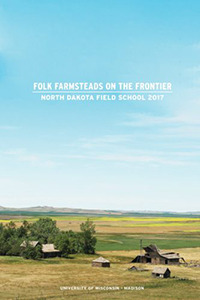Published On: July 1, 2019
The book Folk Farmsteads on the Frontier: North Dakota Field School 2017, by the University of Wisconsin – Madison, had been added to the Institute for Regional Studies Archives book collection. The following book description comes from the book preface:
“The fieldschool that is the subject of this e-book is the result of an agreement between Brady Wind Energy Center I and II (Brady Wind) and the State Historical Society of North Dakota (SHSND). When Brady Wind began planning for the construction of the Brady Wind I and Brady Wind II Energy Centers, two wind farms located in southern Stark County and northern Hettinger County, it became clear that the projects would each require a Certificate of Site Compatibility from the North Dakota Public Service Commission. This requirement made the projects subject to review by the SHSND under North Dakota Century Code (NDCC) 49-22 – North Dakota Energy Conversion and Transmission Facility Siting Act. Brady Wind hired Tetra Tech, Inc. to perform the cultural resources surveys required to provide the SHSND with sufficient information to understand the above ground historic resources in the vicinity of the proposed wind farms. During that process, Tetra Tech identified a number of historically important historic buildings and farmsteads generally associated with the Germans from Russia population that settled in the area at the end of the nineteenth and beginning of the twentieth centuries.
The SHSND reviewed the information collected by Tetra Tech about the proposed projects and the historic buildings in the area, and requested Brady Wind to undertake mitigative actions to ameliorate the effect of adding wind turbines to the historically bucolic area. After discussions involving the SHSND, Brady Wind, and Tetra Tech, the SHSND accepted the proposal from Brady Wind to fund a fieldschool for students of architectural history and the documentation of some of the historic structures within the vicinity of the proposed wind farms.
The goal of the mitigation was not only to record these buildings, a standard mitigative action, but also to better understand this collection of buildings and, most importantly, to present these findings to a wider audience than normally sees architectural documentation. By involving students in the fieldschool and producing a document aimed at the general public rather than a specialist architectural historian audience it was hoped that the mitigation might pique the curiosity of future historians about North Dakota’s rich historical legacy, and provide the local residents with a better understanding of the landscape they traverse daily.”


